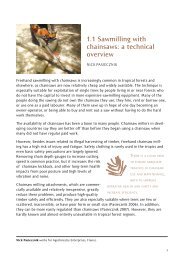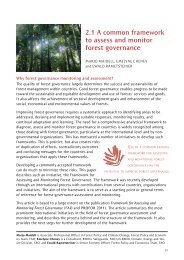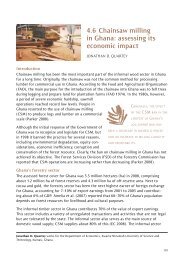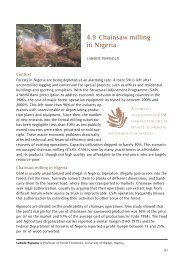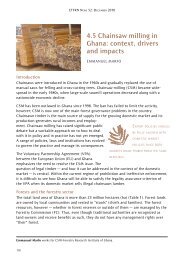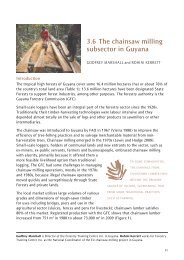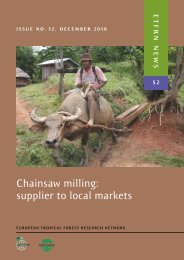Chainsaw milling: supplier to local markets - European Tropical ...
Chainsaw milling: supplier to local markets - European Tropical ...
Chainsaw milling: supplier to local markets - European Tropical ...
You also want an ePaper? Increase the reach of your titles
YUMPU automatically turns print PDFs into web optimized ePapers that Google loves.
166<br />
ETFRN NEws 52: DEcEmbER 2010<br />
4.7 chainsaw <strong>milling</strong> in<br />
kenya<br />
GEORGE M. MUTHIKE, DOUGLAS SHITANDA,<br />
CHRISTOPHER L. KANALI and FRED N. MUISU<br />
kenya’s forest resources<br />
kenya is internationally considered <strong>to</strong> have low forest cover since less than 10% of its<br />
569,250-km 2 land area is classified as forest area (mEnr 2005). nevertheless, the forest<br />
sec<strong>to</strong>r provides forest-related goods and services and is a vital part of the livelihoods of<br />
the kenyan people. The forest’s most significant contributions are energy for domestic<br />
and industrial processes, timber for construction and environmental services such as<br />
regulation of water flows, regulation of <strong>local</strong> climate conditions and provision of carbon<br />
reservoirs and sinks. it is estimated that 80% of the population uses biomass wood for<br />
energy while urban people rely heavily on hydro-electric power (luvanda and muthike<br />
2008).<br />
The forests contain 50% of the nation’s tree species, 40% of larger mammals and 30% of<br />
birds. indigenous forests also contain some endemic and threatened species. in addition,<br />
they serve as cultural, ceremonial and recreational sites<br />
and provide a variety of non-timber products.<br />
The high demand<br />
most closed canopy forests are gazetted forest reserves<br />
for Timber in<br />
managed by the newly established kenya Forest service<br />
kenya and The<br />
(kFs). a few gazetted areas are national parks or game<br />
ban on logging<br />
reserves managed by the kenya wildlife service (kws).<br />
an estimated 100,000 ha of forests are managed by<br />
county councils, which hold the land in trust on behalf of<br />
the <strong>local</strong> people. Forest exploitation in these trust land<br />
areas is often not well managed. in some cases, <strong>to</strong>tal deforestation has taken place due <strong>to</strong><br />
a lack of capacity in the councils <strong>to</strong> manage these forests. an unknown area of indigenous<br />
forest is privately owned. although these holdings tend <strong>to</strong> be small, they are considered<br />
important for water catchments and environmental conservation. Their exploitation is<br />
also difficult <strong>to</strong> control.<br />
operaTions in foresT planTaTions<br />
drive on-farm Timber processing.<br />
George m. muthike works for the kenya Forestry research institute; Douglas shitanda and chris<strong>to</strong>pher<br />
L. Kanali work for the Jomo kenyatta university of agriculture and Technology; and Fred N. muisu works for<br />
the Department of Forestry and wood science, moi university.



